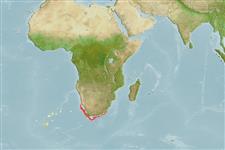Élasmobranches (requins et raies) (sharks and rays) >
Rajiformes (Skates and rays) >
Rajidae (Skates)
Etymology: Rajella: Latin, raja, -ae = a sting ray (Raja sp.) (Ref. 45335).
Environment: milieu / climate zone / depth range / distribution range
Écologie
marin bathydémersal; profondeur 102 - 1098 m (Ref. 106604). Deep-water; 27°S - 40°S
Southeast Atlantic: Lüderitz, Namibia to off Cape Agulhas, South Africa.
Taille / Poids / Âge
Maturity: Lm ? range ? - ? cm
Max length : 65.1 cm TL mâle / non sexé; (Ref. 106604)
Description synthétique
Clés d'identification | Morphologie | Morphométrie
Small skate with a very short, obtusely pointed snout, large, close-set, bulging eyes and a thick disc; tail thick and much longer than body; conspicuous light thorns make disc and tail very rough (Ref. 5578). Light grey to brownish above, with or without darker spots; young with distinctive white-barred pattern; underside white (Ref. 5578).
Found on the upper slope (Ref. 5578). Feed on mysids, lightfishes, and polychaetes (Ref. 5578). Oviparous (Ref. 50449). Eggs have horn-like projections on the shell (Ref. 205). Caught by hake trawlers (Ref. 5578).
Life cycle and mating behavior
Maturité | Reproduction | Frai | Œufs | Fécondité | Larves
Oviparous, paired eggs are laid. Embryos feed solely on yolk (Ref. 50449).
McEachran, J.D. and K.A. Dunn, 1998. Phylogenetic analysis of skates, a morphologically conservative clade of elasmobranchs (Chondrichthyes: Rajidae). Copeia 1998(2):271-290. (Ref. 27314)
Statut dans la liste rouge de l'IUCN (Ref. 130435: Version 2024-2)
Menace pour l'homme
Harmless
Utilisations par l'homme
Pêcheries:
Outils
Articles particuliers
Télécharger en XML
Sources Internet
Estimates based on models
Preferred temperature (Ref.
123201): 6.5 - 13.8, mean 8 °C (based on 11 cells).
Phylogenetic diversity index (Ref.
82804): PD
50 = 0.5000 [Uniqueness, from 0.5 = low to 2.0 = high].
Bayesian length-weight: a=0.00295 (0.00169 - 0.00514), b=3.24 (3.09 - 3.39), in cm total length, based on LWR estimates for this species & (Sub)family-body (Ref.
93245).
Niveau trophique (Ref.
69278): 3.6 ±0.53 se; based on food items.
Résilience (Ref.
120179): Faible, temps minimum de doublement de population : 4,5 à 14 années (Fec assumed to be <100).
Fishing Vulnerability (Ref.
59153): Moderate to high vulnerability (46 of 100).
